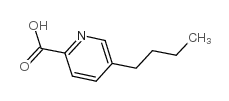Fusaric acid

Fusaric acid structure
|
Common Name | Fusaric acid | ||
|---|---|---|---|---|
| CAS Number | 536-69-6 | Molecular Weight | 179.21600 | |
| Density | 1.113g/cm3 | Boiling Point | 329.2ºC at 760mmHg | |
| Molecular Formula | C10H13NO2 | Melting Point | 96-100 °C | |
| MSDS | Chinese USA | Flash Point | 152.9ºC | |
| Symbol |

GHS07 |
Signal Word | Warning | |
|
Characterization of TolC efflux pump proteins from Pasteurella multocida.
Antimicrob. Agents Chemother. 52 , 4166-71, (2008) Two TolC homologs, PM0527 and PM1980, were identified for Pasteurella multocida. A pm0527 mutant displayed increased susceptibility to a range of chemicals, including rifampin (512-fold) and acridine orange (128-fold). A pm1980 mutant showed increased suscept... |
|
|
Chemical genetics reveals a complex functional ground state of neural stem cells.
Nat. Chem. Biol. 3(5) , 268-273, (2007) The identification of self-renewing and multipotent neural stem cells (NSCs) in the mammalian brain holds promise for the treatment of neurological diseases and has yielded new insight into brain cancer. However, the complete repertoire of signaling pathways ... |
|
|
Identifying chelators for metalloprotein inhibitors using a fragment-based approach.
J. Med. Chem. 54 , 591-602, (2011) Fragment-based lead design (FBLD) has been used to identify new metal-binding groups for metalloenzyme inhibitors. When screened at 1 mM, a chelator fragment library (CFL-1.1) of 96 compounds produced hit rates ranging from 29% to 43% for five matrix metallop... |
|
|
Determination of the Mycotoxin Content in Distiller's Dried Grain with Solubles Using a Multianalyte UHPLC-MS/MS Method.
J. Agric. Food Chem. 63 , 9441-51, (2015) There are more than 300 potential mycotoxins that can contaminate food and feed and cause adverse effects in humans and animals. The data on the co-occurrence of mycotoxins in novel animal feed materials, such as distiller's dried grain with solubles (DDGS), ... |
|
|
Fusaric acid induces a notochord malformation in zebrafish via copper chelation.
Biometals 28 , 783-9, (2015) Over a thousand extracts were tested for phenotypic effects in developing zebrafish embryos to identify bioactive molecules produced by endophytic fungi. One extract isolated from Fusarium sp., a widely distributed fungal genus found in soil and often associa... |
|
|
Impact of biological control agents on fusaric acid secreted from Fusarium oxysporum f. sp. gladioli (Massey) Snyder and Hansen in Gladiolus grandiflorus corms.
J. Ind. Microbiol. Biotechnol. 38(1) , 21-7, (2011) Fusaric acid (FA) (5-n-butylpuridine 2-carboxyl acid), a highly toxic secondary metabolite produced by Fusarium oxysporum strains, plays a significant role in disease development. The abilities of three F. oxysporum f. sp. gladioli (Massey) Snyder and Hansen ... |
|
|
Yeast polysaccharide affects fusaric acid content in maize root rot.
Chem. Biodivers. 2(12) , 1685-90, (2005) Protective action of sulfoethyl glucan (SEG), a derivative of the cell wall glucan prepared from the baker's yeast Saccharomyces cerevisiae, was investigated in the maize seedlings infected by a plant pathogen Fusarium verticillioides (Sacc.). Several markers... |
|
|
Antimycobacterial activity of fusaric acid from a mangrove endophyte and its metal complexes.
Arch. Pharm. Res. 34(7) , 1177-81, (2011) Due to the increasing prevalence of multidrug-resistant Mycobacterium tuberculosis, there is an urgent need for new antituberculosis drugs that have novel mechanisms of action. As part of our ongoing search for antimycobacterial metabolites from mangrove endo... |
|
|
Cu(II): a "signaling molecule" of the mangrove endophyte Fusarium oxysporum ZZF51?
Biometals 23(6) , 1053-60, (2010) We previously reported the isolation of Cu-fusaric acid (Cu-FA) complex from the mangrove endophyte Fusarium oxysporum ZZF51. In this study, we explored the mechanism of Cu-FA production in the strain ZZF51 by comparing with that of another endophyte Fusarium... |
|
|
Fusaric acid modulates Type Three Secretion System of Salmonella enterica serovar Typhimurium.
Biochem. Biophys. Res. Commun. 449(4) , 455-9, (2014) Natural small-molecule products are promising lead compounds for developing a generation of novel antimicrobials agents to meet the challenge of antibiotic-resistant pathogens. To facilitate the search for novel anti-virulence agents, we chose a virulence fac... |